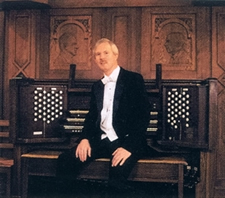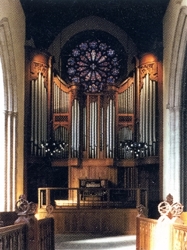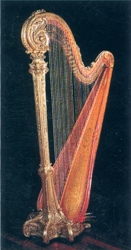| Rebecca Flannery (harp) Liesl Odenweller (Soprano) John Rose (organ) |
Buy this album now CD: £14.00 + p&p |
| This Son So Young | Louie White | |
| 1 | Antiphon | |
| 2 | Recitative | |
| 3 | Air - This Son So Young | |
| 4 | Recitative | |
| 5 | Air - Rise, My Son | |
| 6 | Antiphon | |
| 7 | Saw You Never | arr. Robert Edward Smith |
| 8 | Le Sommeil de l'Enfant Jésus | Henri Büsser |
| 9 | Epiphany Carol | Malcolm Williamson |
| Reflections on Southern Hymn Tunes | Louie White | |
| 10 | My Shepherd Will Supply My Need | |
| 11 | Organ Reflection | |
| 12 | What Wondrous Love Is This | |
| 13 | Organ Reflection | |
| 14 | When I Can Read My Title Clear | |
| 15 | Organ Reflection | |
| Parables | Robert Edward Smith | |
| 16 | The Windhover | |
| 17 | Pied Beauty | |
| 18 | God's Grandeur | |
| 19 | Ave Maria | Bach/Charles Gounod |
| 20 | O Divin Rédempteur | Charles Gounod |
Sleeve Notes
The young American soprano Liesl Odenweller maintains an active career in both the United States and Europe. Equally at home on the operatic stage and in concert halls, her versatility as an artist enables her to successfully navigate the complexities of extremely diverse types of repertoire. She has received much acclaim for her portrayals of Gilda in Rigoletto, Konstanze in Die Entführung aus dem Serail, and Pamina in Die Zauberflöte, as well as her sensitive interpretation of recital repertoire by Rossini, Debussy, and Tosti. She made her Lincoln Center debut in 1997 at Avery Fisher Hall in the premiere of a new work, and she is scheduled to sing the debut performances of an opera and a song cycle in Italy in 1999. Liesi Odenweller has been featured in performance on Italian television, and has been a recipient of numerous awards and grants, including the Liederkranz Prize, the International Bellini Prize, and the Italian Prize entitled "II Virtuoso." |
It has been my privilege to be personally associated with three of the composers whose works are heard on this recording: Louie White, Malcolm Williamson and Robert Edward Smith. I became acquainted with them during my tenure at the Cathedral Basilica of the Sacred Heart in Newark, New Jersey, in the late '60's and '70's. While a student at Rurgers University I became acquainted with Louie White as one of his students. Only gradually (because he was such a modest person) did I begin to learn of his considerable accomplishments as a composer. Upon first hearing his music I was immediately captivated by the beauty and originality of his elegantly crafred scores. This Son So Young extracts maximum effect from the tonal colors and resources of the voice, harp and organ. This remarkable work won the 1952 composition award ($IOO!) from Church of the Ascension in New York City. It was dedicated to the American counter-tenor, Russell Oberlin, and was published by the H.W. Gray Co. I first performed the organ
part of this cantata in 1977 with soprano Louise Natale and Robert
Edward Smith (who is represented on this recording as a composer)
playing the harp part on harpsichord. Louie White had happily sanctioned
using the harpsichord as a substitute for the original scoring
for that performance. During that period I had the joy of performing
on numerous occasions with the lare Louise Natale, a favorite soprano
ofToscanini, who was for many years the soprano soloist of the
Riverside Church in New York where she sang accompanied by my teacher,
the legendaty organist Virgil Fox. A native of the Spartanburg, South Carolina, Louie White loved the haunting melodies of the Southern mountain hymn tunes upon which his Reflections are based. The tune heard before and after Wondrous Love is an original hymn tune by Louie White. Louie White was also well known and respected as a singer and choral conductor. His works include songs, choral works, cantatas, and instrumental works including Concerto ftr Harpsichord (1960) which was commissioned by the Spoleto Festival in Italy. A champion of his music has been Leontyne Price who performed his works at Carnegie Hall and Town Hall in New York and in a nationally televised concert from the White House in 1978. Upon heating of his death Miss Ptice said: "I have lost a dear friend, who was a distinguished composer." I met Malcolm Williamson while waiting in a receiving line for Olivier Messiaen and Yvonne Loriod-Messiaen following their program for two pianos at Hunter College. At that time Malcolm Williamson was Artist-in-Residence at Westminster Choir College in Princeton, New Jersey. Shortly thereafter I invited him to perform on the organ series at the Newark Cathedral and we became friends. From then on I performed a great deal of his music, especially with the Carhedral Choir of Men and Boys. The organ accompaniment heard in the Epiphany Carol was composed especially for the annual Cathedral Carol Sing which Louise Natale and I were about to perform. It became an instant favorite and she repeated it at that annual event for a number of years. A native of Australia, Malcolm Williamson is now Master of the Queen's Music to H.M. Queen Elizabeth II of Great Britain, a post he has held since 1975. He is a dynamic and extremely versatile composer of opera, orchestral, piano, organ, choral and vocal works. My first encounter with Robert Edward Smith was as a dazzled audience member at one of his harpsichord recitals. A short while later he became my associate at Sacred Heart Cathedral where he regularly accompanied the Choir of Men and Boys. Only then did I discover that he also possessed remarkable talents as a composer. I quickly became the "pest" who constantly asked him to compose more works for the choir to sing. After becoming College Organist and Director of Chapel Music at Trinity College, Hartford, I arranged for Robert to be appointed Composer-inResidence of the Trinity College Chapel, a post he accepted in 1979 and holds to this day. The Trinity College Chapel Singers, along with countless choirs around the country, enjoy singing his beautiful choral works which, in part, have been inspired by the Trinity College Chapel's sumptuous acoustics. During one of the recording sessions for this CD, while we were trying to decide how to rearrange the SATB choral score of Saw You Never In The Twilight, Robert happened by the Chapel to see how the sessions were progressing. After asking his advice he requested some manuscript paper, sat down on the steps of the Music Gallery and wrote a beautiful new counter melody for Liesl (whom we have both known since her student days at Trinity College), solving the quandary in about two minutes flat! Parables was written in 1979 and was first performed by the late tenor Paul Otlando. In addition to his work as a widely published composer, Robert Edward Smith continues his career as one of the world's finest concert and recording harpsichordists. John Rose |
|
Harpist Rebecca Flannery has appeared as soloist and in chamber music and orchestral positions throughout Europe and the United States. She has performed in Carnegie Recital Hall, Lincoln Center, and for WQXR in New York. Ms. Flannery is a founder of Chrysolith (harp, flute, viola, soprano) and the New York Harp Ensemble and Chamber Musicians' Alliance. Chamber works by five different composers were dedicated to, written and arranged for her and her colleagues in Chrysolith which for twelve years actively toured the United States and Canada. She first recorded for Towerhill Records in 1980. She has performed under the baton of such noted conductors as Georg Solti, Aaron Copland, Blanche Moyse, and Ono Werner Mueller and has appeared on television and radio in both the US and Europe. Immediately upon receiving her Master of Music Degree from the Yale School of Music, where she won the prestigious Sprague-Woolsey Hall Concerto Competition, Ms Flannery was appointed to the teaching position in harp at the Hartt School of Music, University of Hartford, Connecticut, a post she continues to hold. Ms. Flannery is in demand both as a private teacher and master class instructor. She is currently the President of the American Harp Society, Connecticut Chapter, and is a founding partner of Harps Unlimited International. |
||
Organist John Rose has performed in fortythree of the United States and in nine other countries on three continents. Performance locations at home have included Orchestra Hall in Chicago, Davies Symphony Hall in San Francisco, The Kennedy Center in Washington, Bushnell Hall in Hartford, and the Mormon Tabernacle in Salt Lake City. Performance locations abroad have included Westminster Abbey and St. Paul's Cathedral in London, Notre Dame Cathedral in Paris, Morelia Cathedral in Mexico, and Town Hall in Melbourne, Austalia. Mr Rose has performed for national conventions of the Organ Historical Society, The National Association of Pastoral Musicians, The American Institute of Organ Builders of America, and for national and regional conventions of the American Guild of Organists. Since 1977 he has been College Organist and Director of Chapel Music at Trinity College, Hartford, and before coming to Trinity spent nine years as Organist and Music Director at the Cathedral Basilica of the Sacred Heart in Newark, New Jersey, where he founded and developed a major concert series. Among several noted composers who have dedicated works to him is Malcolm Williamson, Master of the Queen's Music to H.M. Elizabeth II of Great Britain whose Epiphany Carol is on this recording. Recordings by Mr. Rose have centered on the literature of the French Romantic era composers which he has made a performance specialty. |
||
The organ was insralled in 1971 by rhe Austlll Organ Company of Hartford. The 79 rank instrument, Austin Organ op. 2536, contains 4,539 pipes. It can be described as "Neo-Classic." While most pipes are made of metal, the largest pipes, those of the 32' Untersatz, are built of pine. The largesr pipe of this stop, low CCCC, is 32 feet long and nearly rwo feet square. This stop was retained from the former Aeolian-Skinner Chapel organ. The smallest pipes in the organ are the size of pencils. The Great, Positiv and Pedal divisions have their own reflective housings to blend and focus the sound down into the choir area of the Chapel. The Great and Pedal choruses are on the upper level, with the Swell divided on the lower level and the Positiv in the front and center of the case. The Trompette de Jubile, the organ's most powerful stop, was added to the organ in 1982 during the Chapel's Jubilee Year. The handsome casework was designed by Charles Nazarian and constructed by his firm in Gloucester, Massachusetts. |
||
The harp heard in rhis recording is rhe one-of-a-kind "Louis XV Special", which was especially designed and built by Lyon & Healy harp makers in Chicago, 1916. Featured in recordings and performed on by noted soloists, this harp, in the collection of Peter S. Reis, was recently on loan for exhibition at the Metropolitan Museum of Art, New York City, and was also included in the official exhibition and catalogue "Our Tuneful Heritage" which featured the best American-made musical instruments. |
||
Credits Produced and Engineered by Raymond Albright Organ Technicians: David Johnston and Samuel HughesRecorded at Trinity College Chapel, Hartford Connecticut Special thanks to: The Rt. Rev. Steven Charleston, Donna Swols, Peter Reis, Al Isaacson, and Phillip Truckenbrod |
||
| Instruments: | Harp, Soprano & Organ |
| Genre: | Classical |
| Format: | CD |
| Our Ref: | A0107 |
| MCPS: | TH-71986 |
| Label: | Towerhill Recordings |
| Year: | 1999 |
| Origin: | USA |
| Artists Web Site | |
| Rebecca Flannery | www.Harps-International.com |
| Liesl Odenweller | www.lieslodenweller.com |
| John Rose |
 "There
is much to appreciate in this recorded performance, especially
the obvious sensitivity of the three artists, Odenweller's pretty
soprano and the equal prominence given the harp and organ. Not
easy with such a tonally differing duo."
"There
is much to appreciate in this recorded performance, especially
the obvious sensitivity of the three artists, Odenweller's pretty
soprano and the equal prominence given the harp and organ. Not
easy with such a tonally differing duo." Liesl
Odenweller
Liesl
Odenweller Rebecca
Flannery
Rebecca
Flannery  John
Rose
John
Rose  The
Trinity College Chapel Organ
The
Trinity College Chapel Organ  The
Harp
The
Harp 



